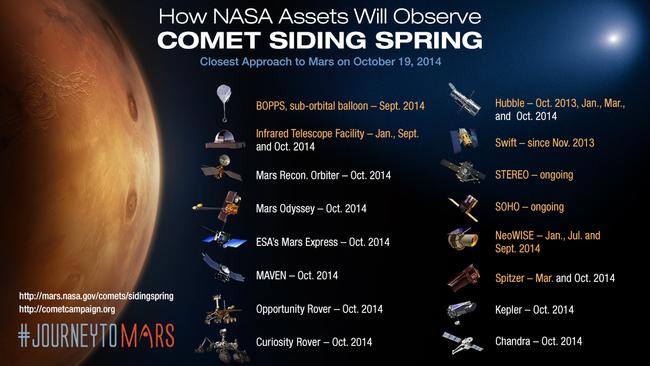Watch comet Siding Spring skim past Mars through the eyes of our robotic space explorers
ROBOTIC eyes have scanned the skies of Mars as an enormous comet skimed past at 200,000km/h.

ROBOTIC eyes have scanned the skies of Mars as an enormous comet skimed past at 200,000km/h.
Rovers on the ground and satellites in space are still watching the once-in-a-million years event — though the mountain-sized clump of ice and rubble was never expected to strike the red planet.
But it came very close.
Image via @Slooh - Comet Siding Spring has passed by Mars. 1 hour for comet debris encounter pic.twitter.com/ddZHaUUvjl
— Gene J. Mikulka (@genejm29) October 19, 2014Comet Siding Spring has hurtled past at a mere 140,000km — barely a whisker by astronomical standards.
The closest pass began at 5am (AEDT) and an array of online services provided live coverage.
#MAVEN IUVS instrument lead, Nick Schneider, is speaking to @Slooh about #MarsComet observations right now | http://t.co/TpXrw7j75Z
— NASA's MAVEN Mission (@MAVEN2Mars) October 19, 2014
NASA had to act — both to protect its Mars probes and to capture as much information as possible about the comet as the planet passes through its tail.

Various Mars orbiters were been manoeuvred to the far side of the planet so they won’t be damaged by any high-speed comet debris. But scientists hoped the Mars Reconnaissance Orbiter, Mars odyssey and MAVEN would capture a lot of data about the fly-by.
Watching out for the #MarsComet & sending best wishes to the orbiters for safe observations! http://t.co/uBfDbYqVOm #duckandcover
— Curiosity Rover (@MarsCuriosity) October 19, 2014
NASA’s two rovers “on the ground” turned their electronic eyes to the sky for the light show. Curiosity and Opportunity are both beaming back pictures they took during the comet’s pass, the US space agency said.
It was discovered by Robert McNaught at Australia’s Siding Spring Observatory in January 2013.

The comet is believed to have originated billions of years ago in the Oort Cloud, a distant region of space on the outskirts of the solar system.
“Comets such as C/2013 A1 are essentially dirty, icy snowballs with rocks and dust embedded in frozen gases,” Nottingham Trent University astronomy expert Dan Brown.
“It is on its first run towards the centre of our solar system, and its material is virtually unchanged by the rays of the sun and can give us an insight into the material composition of our early solar system 4.6 billion years ago.”
The comet, about 1.6km in diameter, is travelling at nearly 200,000km per hour and is only about as solid as a pile of talcum powder.




